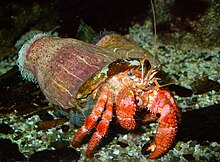
Back Paguroidea Afrikaans السرطان الناسك Arabic السرطان الناسك ARZ Omang-Omang BAN Umang BCL Ракі-пустэльнікі Byelorussian Komang-komang BEW Раци отшелници Bulgarian সন্ন্যাসী কাঁকড়া Bengali/Bangla Paguroïdeus Catalan
| Hermit crab Temporal range:
| |
|---|---|

| |
| Dardanus calidus | |
| Scientific classification | |
| Domain: | Eukaryota |
| Kingdom: | Animalia |
| Phylum: | Arthropoda |
| Class: | Malacostraca |
| Order: | Decapoda |
| Suborder: | Pleocyemata |
| Infraorder: | Anomura |
| Superfamily: | Paguroidea Latreille, 1802 |
| Families | |
Hermit crabs are anomuran decapod crustaceans of the superfamily Paguroidea that have adapted to occupy empty scavenged mollusc shells to protect their fragile exoskeletons.[1][2][3] There are over 800 species of hermit crab, most of which possess an asymmetric abdomen concealed by a snug-fitting shell. Hermit crabs' soft (non-calcified) abdominal exoskeleton means they must occupy shelter produced by other organisms or risk being defenseless.
The strong association between hermit crabs and their shelters has significantly influenced their biology. Almost 800 species carry mobile shelters (most often calcified snail shells); this protective mobility contributes to the diversity and multitude of these crustaceans which are found in almost all marine environments. In most species, development involves metamorphosis from symmetric, free-swimming larvae to morphologically asymmetric, benthic-dwelling, shell-seeking crabs. Such physiological and behavioral extremes facilitate a transition to a sheltered lifestyle, revealing the extensive evolutionary lengths that led to their superfamily success.
- ^ Patsy McLaughlin & Michael Türkay (2011). Lemaitre R, McLaughlin P (eds.). "Paguroidea". World Paguroidea & Lomisoidea Database. World Register of Marine Species. Retrieved November 25, 2011.
- ^ Cite error: The named reference
checklistwas invoked but never defined (see the help page). - ^ Hazlett, B.A. (1981). "The Behavioral Ecology of Hermit Crabs". Annual Review of Ecology and Systematics. 12 (1): 1–22. doi:10.1146/annurev.es.12.110181.000245. ISSN 0066-4162.